 Economy
Economy

“The country’s economy now looks like a train running on an inclined plane at a slow speed”, an economist from the National Economic University (NEU) has said, predicting two growth scenarios for this year, both of which are lower than targets approved by the National Assembly.
 |
| Electronics components being manufactured at Japan-invested Nidec Sankyo Việt Nam Co in HCM City. - VNA/VNS Photo Thanh Vũ |
HÀ NỘI — “The country’s economy now looks like a train running on an inclined plane at a slow speed”, an economist from the National Economic University (NEU) has said, predicting two growth scenarios for this year, both of which are lower than targets approved by the National Assembly.
Prof. Dr. Ngô Thắng Lợi made the statement on Thursday while addressing the conference "Prospects of Việt Nam’s economy and the State’s role in the improvement of institution and business environment” which focused on identifying opportunities and challenges faced by the national economy and prospects for socio-economic development between 2017 and 2020.
According to the resolution for socio-economic development in 2017 approved by the National Assembly, the country is aiming for growth rates in Gross Domestic Product (GDP) and Consumer Price Index (CPI) set at 6.7 per cent and 4 per cent, respectively.
However, Lợi said that in the better scenario, GDP growth could hit 6.6 per cent with inflation of 5.4 per cent, while in the worst case, the figures would be 6 per cent and 4.3 per cent.
He said that the pessimistic outlook was put forth based on analysis of the current export-led and natural resource-depending growth model. Last year, the country saw a signal of an unexpected shifting of economic structure.
In 2015, the economic growth rate was much improved mostly thanks to the industry-construction sector, but last year, the sector saw a significant decrease in growth, dragging down the whole economy.
Specifically, the industry-construction sector grew by 7.57 per cent in 2016, lower than the 9.64 per cent of the previous year, and contributed only 2.59 percentage points to the 2016 economic growth, compared to 3.2 percentage points in 2015.
The plummet was attributed to the strong reduction in the output of the mining sector. Crude oil and coal output saw a decrease of over 1.67 and 1.26 million tonnes respectively in 2016.
The mining industry development index also declined by 4 per cent against 2015.
These figures showed that natural resources were used close to exhaustion, and a growth model based on exploiting natural resources was coming to the end, Lợi said.
Regarding economic components, the foreign direct investment (FDI) sector was the main driving forces of the export growth rate, while domestic firms were still weak with low productivity.
In 2016, the FDI sector recorded an estimated export value (including crude oil) of US$125.9 billion, up 10.2 per cent from 2015 and accounting for 73 per cent of the country’s total export revenue.
The sector contributed $23.7 billion to the country’s trade turnover, which helped offset the increasing trade deficit caused by domestic firms ($21 billion).
Due to these factors, it was necessary for the country to renovate its growth model, he said.
The solutions he suggested were increasing investment in high-tech agriculture to create more value-added products adaptable to climate change, in high-quality human resource training and in support to private enterprise, along with improving the quality of State-owned enterprises’ equitisation and attracting FDI.
Deputy Head of the Central Economic Committee Nguyễn Ngọc Bảo highlighted the need to create an equal business environment for all in the economy because the economic growth drivers for 2017 will be private companies, domestic consumers and infrastructure investment.
The event was organised by National Economics University, in co-operation with the Central Economic Committee and the National Assembly’s Economic Committee.
The same day, the university launched its annual publication named “Việt Nam’s economy 2016: Restructuring the economy with the renovation of growth model and State’s role in its development”. — VNS









